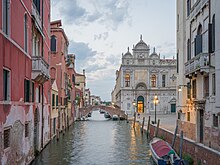User:Jlipinski43/Miracle of the Slave (Tintoretto)

The Miracle of the Slave (also known as The Miracle of St. Mark) is a painting completed in 1848 by the Italian Renaissance artist Jacopo Tintoretto. Originally commissioned for the Scuola Grande di San Marco, a confraternity in the city of Venice, the work has been held in the Gallerie dell'Accademia since 1815.[1]
The painting portrays Saint Mark, patron saint of Venice, performing a posthumous miracle of saving a slave from torture. Drawn from hagiographic sources on the saint’s life, like Jacobus de Voragine's Golden Legend, Saint Mark appears at the top of the image after being summoned by the slave, destroying the tools used in his torture and stunning the crowd.[2]
Miracle has been described as Tintoretto’s public consecration in Venice, and has classic components of the Venetian school of art along with themes that would become prevalent throughout the artist's forthcoming career.[1]
Description
[edit]

Miracle of the Slave was commissioned along with 3 other large canvases portraying St. Mark to Tintoretto by the charitable civic organization of the Scuola Grande di San Marco to hang opposite the altar within the building. The work hung in the Scuola until seized by the French in 1797. It was then returned to Venice in its current location at the Gallerie dell'Accademia in 1815.[1]
The image tells the hagiography of a slave who lived long after the life of St. Mark, using fellow Venetian artist Jacopo Sansovino's bronze relief created for the pulpit in St. Mark's Basilica as inspiration.[3] Prior to the picture, the slave wants to visit the tomb of the patron saint of Venice, but the slave’s master forbids his visit. The slave makes the pilgrimage against his master’s will, and devotes his body to St. Mark upon reaching the tomb. The image in the painting is of the slave’s arrival back to his master's residence, where the master is punishing the slave for leaving.[4] The master, seated at the throne on the right, calls for the slave’s eyes gouged out, legs broken, and mouth shattered. However, the instruments of torture continue breaking next to slave as he calls for St. Mark, presumably from the intervention of the patron saint of Venice at the top of the image. Stunned, the crowd on the left side of the image is convinced of a miracle.[2]
Miracle is a classic example of a work from the Venetian Gothic school. The piece is daring in its use of color to organize its composition.[2] In particular, the juxtaposition of depth created by the vibrant pink of the garb of St. Mark contrasted with brilliant white turban below him creates a sense of depth that makes the figure of the saint stand out in the air.[3]
Context
[edit]Miracle of the Slave was Tintoretto’s first notable work of his career. Prior to Miracle, Tintoretto did not have enough backing in order to bring him to the attention of the elites.[5] The artist was continually told his brushwork was too rushed and works were unfinished. In particular, the famous Venetian Titian was an open critic of Tintoretto’s work to this point.[6]

Miracle was, from the beginning, the biggest commission Tintoretto had received. The confraternity that paid for the work, the Scuola di San Marco, was the largest and wealthiest lay organization in Venice, and it played a central role in social life. However, the work was not met with immediate success; some members of the confraternity originally insisted the painting be returned Tintoretto. Various theories exist as to the cause of the dispute over the work, ranging from Tintoretto's personality to favoritism from Tintoretto's father-in-law, who held a leadership position within the Scuola. Ultimately, though, upon installation inthe public eye, Miracle of the Slave was met with praise and opened up a slew of new works commissioned to Tintoretto.[5]
Interpretation
[edit]Many scholarly authors have placed Miracle of the Slave in the context of Tintoretto's career. One such interpretation is of Tintoretto's painting of religious narrative, a common theme of the Venetian artist. Contemporary biographer Carlo Ridolfi wrote that Tintoretto changed the course of religious painting in Venice, as everyone after him painted scenes with the "great strength and energy used that he expressed through his figures".[4] More recently, authors have placed Miracle at the beginning of Tintoretto's theme of miraculous intervention, which he painted about often in his commissioned work in Venice.[7]
References
[edit]- ^ a b c "The Miracle of the Slave, also known as The Miracle of Saint Mark | Gallerie dell'Accademia di Venezia". gallerieaccademia.it. Retrieved 2024-03-17.
- ^ a b c "Smarthistory – Jacopo Tintoretto, The Miracle of the Slave". smarthistory.org. Retrieved 2024-03-17.
- ^ a b Hills, Paul (2009). "Tintoretto and the Venetian Gothic". Jacopo Tintoretto (1 ed.). Madrid: Museo Nacional del Prado. pp. 13–16. ISBN 978-84-8480-171-9.
- ^ a b Ilchman, Frederick (2007). "Tintoretto as a Painter of Religious Narrative". Tintoretto, 1518-1594. Madrid: Museo Nacional del Prado. pp. 66–67. ISBN 9788484801023.
- ^ a b Echols, Robert (2007). "The Decisive Years: 1547-1555". Tintoretto, 1518-1594. Madrid: Museo Nacional del Prado. pp. 213–215. ISBN 9788484801023.
- ^ Nichols, Tom (1999). Tintoretto : tradition and identity. Internet Archive. London : Reaktion. ISBN 978-1-86189-043-6.
- ^ Levey, Michael (1965). "Tintoretto and the Theme of Miraculous Intervention". Journal of the Royal Society of Arts. 113 (5109): 707–725. ISSN 0035-9114.
